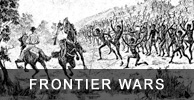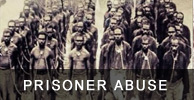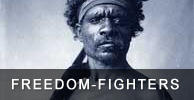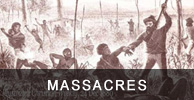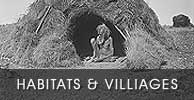Mapping the massacres of Queensland Aboriginal society
 'Conspiracy Of Silence' - Blood baths of the past by Dr T Bottoms
'Conspiracy Of Silence' - Blood baths of the past by Dr T Bottoms

A Story of Modern Australia by AJ Vogan 1889 (image cropped)
Nicolas Rothwell The Australian 29 June 29 2013
In October 1890, Archibald Meston, a handsome, slightly scapegrace pillar of the Queensland establishment, felt the time had come for a brisk assessment of the state's dark and conveniently ill-remembered past. At that point in his hectic career Meston was still in his 30s and had already been by turns a wordsmith, a parliamentarian, an explorer, a newspaper editor and a bankrupt: now he was on the verge of a new chapter in his life, as protector of the Aborigines. It was a title replete with ironic undertones.
Meston set out his portrait of the decades gone by in blunt terms in The Queenslander, a weekly with wide distribution: "The records of those unhappy years are unspeakably ghastly in their accounts of murders of white men and slaughter of the blacks. The whites were killed in dozens, the blacks in hundreds." The archives of Queensland history groan with telltale passages of this kind: reports and reminiscences that make plain the scale of the bloodshed on the northern frontier during the period of colonial settlement and conquest, when the Australian hinterland was being discreetly, violently cleared and claimed.
Conspiracy of Silence, by Cairns-based historian Timothy Bottoms, provides an overview of our understanding of this bleak phase in the formation of north Australia and builds on much previous work. For most of the century just past, the act of dispossession at the heart of the national story was airbrushed out of memory. But in the 19th century, when the vast expanses of Queensland beyond the Dividing Range were being tamed and taken, a different kind of bid to tilt and accent the record of events had been in place: a double pattern of censorship and attempts at unveiling. As the killings multiplied, the perpetrators concealed the evidence or minimised their scale; meanwhile witnesses and whistleblowers waged a campaign of disclosures. Thus a struggle for interpretation of the frontier landscape was already under way and its weighting was familiar: the press and conscience-stricken agitators fighting to expose the actions and the inaction of the political class.
This pattern complicates the task of the contemporary historian. What counts as evidence? How well does the record of facts set down capture the flow of cause and consequence? Reappraisal of the colonial era has been under way for almost a generation now, since the first frontier works by Henry Reynolds and Raymond Evans appeared in the 1980s. Evans contributes a brief foreword to this study, setting the context, sketching the latest updates in the task of reassessment: "It has now become clear," he says, "that the killing incidents occasioned by the state-financed, equipped and run Native Police squads which operated in Queensland for more than half a century between 1849 and the 1900s would have numbered in the thousands" - and these officially sanctioned killings were supplemented by freelance shootings and poisoning episodes.
Bottoms collects a rich supply of testimony: from publications, new and period; from his own field interviews and research. He confirms the consistent picture of an advancing northward tide of clash and resistance. Strikingly, he provides illustration in the form of a set of maps: "Some Massacres on the Queensland Frontier", he offers as his heading for them, modestly, tellingly; they may be the most comprehensive "massacre maps" yet published for the era of Australian settlement.
They do their work. Not even experts in the records of the archives could be familiar with every episode marked here by a little map-dot: Birdsville, Burketown, Coen, Wyandotte. It may be that a handful of these cases hover on the edge of the historical record; the total picture is more difficult to brush away.
Bottoms tells his own tale in brief, to make a simple point. He grew up in provincial towns such as Naracoorte and Albury, "blithely unaware of Aboriginal Australia". He became a teacher, working at Santa Teresa just south of Alice Springs, and then in Kowanyama in western Cape York. In these remote communities he was thrown together with the locals: he became aware of their way of seeing the landscape, and their traditions and beliefs. Next Cairns. There was a large regional Aboriginal population. Their stories were unknown. He made himself their scribe and published a heartfelt portrait of their past, Djabugay Country. He was commissioned to write a history of Cairns by the local council; he wrote it: the manuscript was vast and impressive in its detail, and full of Aboriginal content. The council refused to publish it on the grounds the cost would be prohibitive.
Undaunted, he pushed on with his projects: "My approach has been to address the thinking reader who wishes to come to terms with and develop an awareness of the elements that comprise Australian history." This is a journey that involves "facing the awful truth", he says, about times long gone. But it also allows the tracing of continuities. For Bottoms, "the political machinations of the past and the subsequent consequences have relevance" today.
His is a fairly standard story of personal enlightenment through study and experience - and the version of the frontier he offers up is pretty much the new standard version endorsed by academic experts: a history once suppressed, now accepted, but not exactly embraced and enshrined at the heart of modern Australia's image of itself. How could it be? Chapter by chapter, region by region, killing by killing, tale by tale, Bottoms builds his mosaic: the punitive expedition to Fraser Island in 1852, the Bendemere and Goulbolba Hill massacres of the 1860s, the 1870s slaughter at Koonchera and Thundapurty waterholes - here they all are.
Many of the episodes Bottoms deals with were small-scale affairs: "massacre" is now defined by historians of the 19th-century frontier as any organised killing of five or more victims. Some, though, were anything but small. At Goulbolba, more than 300 people were shot or drowned and their skulls and bones could be seen scattered in the surrounding hills for years afterwards, until a succession of sharp bushfires burned the landscape clean.
On the Upper Dawson River in central Queensland, at Hornet Bank station, a notorious attack by Yiman tribesmen claimed the lives of 11 whites, including seven members of one family. The less well publicised retribution was so savage it resulted in the killing of as many as 300 Aborigines and virtually depopulated the area; indeed, Steele Rudd's father, Thomas Davis, used to ride through that scrub country in the years afterwards and "saw the bleaching bones of the dead blacks strewn here and there - a gruesome sight - full-ribbed bodies, fleshless arms, disjointed leg-bones and ghastly grinning skulls peeping out of the grass".
Frontal assaults, ambushes, mounted raids, large-scale cross-country drives and dragnets - different means of attack were employed in different regions, but often the personnel involved were the same: white men with experience of this low-level form of war would move with the frontier, and what they knew of bush conflict was invaluable. The key enforcers, though, were mercenaries, if of a distinctive kind: the Native Police squads - young Aboriginal men removed from their own country and enlisted as shock troops in regional pacification campaigns; coerced, rewarded, paid with the privilege of survival and power: the militia of a shadow world.
Their success was easy enough to measure, but harder to broadcast or proclaim. The Queensland authorities adopted a tactful register of language, for there was a constant need to balance the announcement of official reprisals with the more general doctrine of concealment. Hence the coded vocabulary that became common in the north, where "dispersal" was the standard euphemism for a successful raid, and "no arrests made" was instantly translatable as "all were killed".
But a certain childish simplicity can be traced in the sources. The aristocrat settler Harold Finch-Hatton in his 1886 frontier memoir describes a "nameless" gentleman who poisoned a large group of Aborigines at Long Lagoon, which stands on Mt Spencer station inland from Mackay, a holding in those days, as it happens, of the Finch-Hatton family: "More than a hundred blacks were stretched out by this ruse of the owner of the Long Lagoon. In a dry season, when the water sinks low, their skulls can occasionally be found half-buried in the mud."
Strychnine seems to have been a popular weapon in the armoury of "first wave" landholders, perhaps because of the alarming disparity in numbers between Aboriginal and incomer. Often the furthest reaches of the frontier proved the most blood-spattered, and often it was the most distinguished explorers and pioneers who were the chief aggressors: Frank Hann and Frank Jardine, for instance, Gulf and Cape pioneers respectively, men whose names a good number of Australia's great ranges and river systems still bear today.
Their current renown and past eager journal-keeping brings their actions to light. Much, though, of what transpired in the far north remains in the darkest obscurity and clues to many an unknown clash lie half-lost in the furthest nooks and crannies of populist prose. Here's Glenville Pike, for instance, the vernacular historian of Cape York, author of the bizarre Unsung Heroes of the Queensland Wilderness, expending his lush style on the Palmer River gold rush country: "Blackfellow Creek was so named because diggers rushing to the Hodgkinson field in March 1876 came upon acres of bones where a whole tribe had obviously been wiped out - an Australian version of the killing fields that has been hidden or whitewashed for nearly 120 years."
Burnings, mass drownings - the list, proof of man's fearful ingenuity, runs on. Raymond Evans is the chief expert in drawing up the balance sheet of deaths. Three years ago he published a statistical calculation extrapolated from a series of monthly reports filed from the Native Police camps that operated in the second half of the 19th century: his conservative estimate is that 24,000 Aborigines were killed in that time by these para-statal militias.
Following Evans, Bottoms puts the combined death toll from Native Police and private killing operations at a figure close to 50,000 for this chapter in Queensland's past.
A strange point in Australia's history has now been reached, in the evolution of this society and its picture of itself. The first generation's worth of reappraisals of the frontier record have now been compiled, the initial controversies have come and gone. Conspiracy of Silence is a recap. As Evans says in his foreword, it functions as "a roadmap back into what seems, from a modern perspective, to be a barely conceivable past".
Where to, then, now - with all our newfound knowledge? We know the narrative and also the intriguing problems of interpretation. We are somewhat unclear, perhaps, about the fine grain of many local details, and so we always shall be - but we are broadly sure about the overall prospect.
Sceptics still have much material to work with: Bottoms repeats here a well-known report from Cyclone Jack, whose grandfather survived a massacre in the Dugandan scrub. Cyclone Jack reported it to self-taught Aboriginal historian Bill Rosser at far-off Urandangie on the Queensland Gulf border 129 years later, a few days before his death at the age of 85. How could a strictly empiricist historian take such a report at face value? How, though, could he not, in some fashion, take it in? The old dilemma looms: is absence of evidence evidence of absence? What of the testaments that old men and women from remote indigenous societies in far north Queensland have offered up, like that of Alma Luke Wason from Kowanyama: "Today," she said, describing the pattern of Cape York's families in 1998, "there are big gaps in the genealogies of the clans of the Top End groups, as well as visiting neighbouring clans, whose territories it was that the Jardines trespassed upon."
History, in such conditions, on such a frontier, is a matter of what remains unwritten as much as what survives in textual form: a thing of masked intentions as much as overt acts. Experts sift the records for traces of official policy and official oversights. The northern colony of 150 years ago was a special zone, with its particularities: in many of its documents truth has no sovereign place and the pattern of actions and reactions becomes an indecipherable blur. And so we stand, gazing back on our past, on the deeds that made the nation, unsure quite what to think, how to feel, what steps to take.
Conspiracy Of Silence: Queensland's Frontier Killing Times
By Timothy Bottoms
Allen And Unwin
258pp, $32.99
Nicolas Rothwell is a senior journalist on The Australian, based in Darwin.

